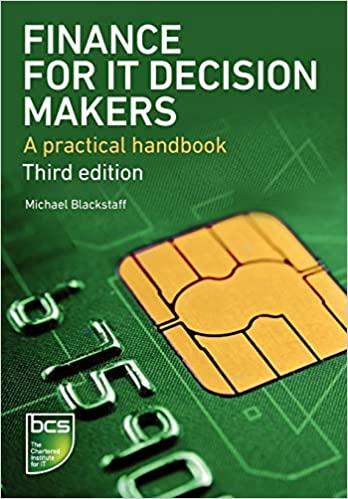Question
Maybe I should just flip a coin Sarah thought as she looked at the proposals in front of her. As the General Manager of Exceed
"Maybe I should just flip a coin" Sarah thought as she looked at the proposals in front of her. As the General Manager of Exceed Energy Inc. it had fallen to her to decide on which, if any, new business ventures Exceed should proceed with. And she was not having an easy time. Exceed had been very successful in providing downhole services throughout the Western Canadian Sedimentary Basin over the past 10 years. Their strategy of having leading edge employee training am above industry compensation levels had allowed them to retain the best employees in an industry where turnover was generally high. This in turn had led to a loyal customer base and consistent annual growth in each of its 2 service lines. Exceed's compensation structure combines a fixed monthly salary, which gives employees stable income regardless of activity, combined with a 'field bonus' equal to a percentage of revenue, Currently each employee receives an average of $60,000 per year salary plus 15% of the revenue generated by the truck during their shift. Any new projects will require employees of similar skills and experience and management belleves it is important to maintain consistent salary levels across all service lines. In looking at growth potential, management feels that the opportunities are fairly limited in the service lines in which they currently compete. So the operating managers were given the directive ta search out other service areas which would complement their operations. Several ideas were investigated and Sarah had assisted them in researching competitors and customers to flesh out the potential returns. The result was 2 potential projects that appear to be desirable. Although the projects would not compete with each other and could be completed together, Sarah fears that taking on both would stretch resources too thin. Project A is something they can do today with some training of existing employees. In order to enter the market they need 3 trucks at $1 million each. Employee training costs will be $10,000 each and will be incurred at the start of the project. Each truck will require 4 employees, which will allow the truck to work approximately 100 hours per week with 2 employees per shift li.e, variable compensation is equal to 30% of revenue). Estimated revenue is $3 million in year 1 with annual increases of 10% thereafter. Management is very comfortable with the accuracy of the revenue estimates as most of the sales will be to existing customers who have indicated they will give business to Exceed if they enter this service line. The equipment is expected to last 5 years and will be depreciated on a straight-line basis over 5 years. Salvage value at the end of 5 years is expected to be $100,000 per truck. Maintenance costs for the equipment will be nominal in year 1 but will increase to $300,000 in year 2 and will increase by 25% annually thereafter. Project B is more complex and willl take longer to train employees and establish market share. It is assumed ermployees (2 per shift, 2 shifts per truck) will be hired at the start of the project and will spend much of the 1" year learning how to use the equipment, refining processes and helping to establish market share. It is estimated that additional training costs incurred during the 1" year will be $50,000 per employee. The total cost of 3 trucks and related equipment is expected to be $5 mililion. Forecast revenue is $500,000 in year 1, $4 mllion in year 2 and growing by 30% per annum thereafter. It is believed this equipment will have a similar life and maintenance requirements to the equipment in Project A, with expected salvage values of $150,000 per truck at the end af 5 years. Actual sales for this project could vary significantly but management is confident they can acquire the required technology and that there is a strong market. Historically, management has found that equipment operating costs, excluding maintenance and salaries, average 10% of revenue. It is also anticipated that Project A will require a working capital investment of $240,000 and that Project B will require working capital of $80,000 at the commencement of the project and a further $220,000 at the end of Year 1. For simplicity, it will be assumed all working capital will be realized at the end of the projects. Sarah has done some legwork and discussed financing alternatives with lenders and existing shareholders. Based on this, she believes the required rate of return for Project A should be 10%. Project B, because of its greater risks, would have a higher required rate of return of 14%. Although Sarah has years of experience with Exceed and understands the business and the numbers very well, she has limited experience with financing and selecting between alternatives with differing cashfiows. Although the company preference is to act on one of these ideas, taking on neither or both are also potential alternatives. Required calculate NPV, IRR and Payback for the 2 projects. In point form, note at least 3 qualitative factors that should be considered in the investment decision Recommend which project is preferable and if none, one or both projects should be undertaken Tax Assumptions Tax rate is 20% CCA rate on equipment is 30% Tax benefits of any losses can be offset against other income in the company
Step by Step Solution
There are 3 Steps involved in it
Step: 1

Get Instant Access to Expert-Tailored Solutions
See step-by-step solutions with expert insights and AI powered tools for academic success
Step: 2

Step: 3

Ace Your Homework with AI
Get the answers you need in no time with our AI-driven, step-by-step assistance
Get Started


